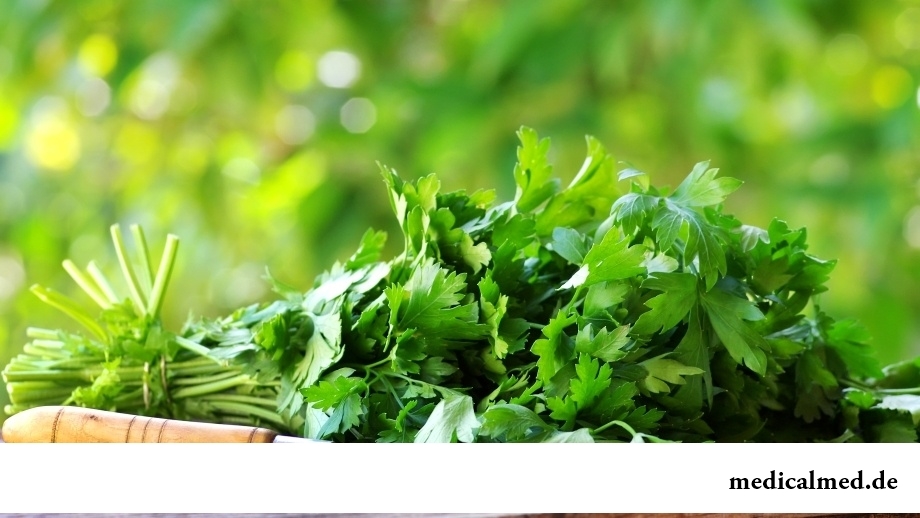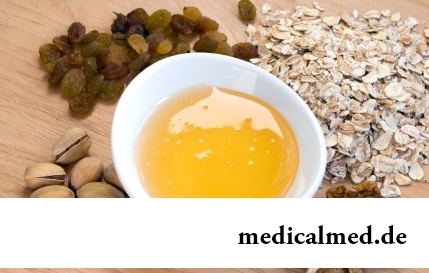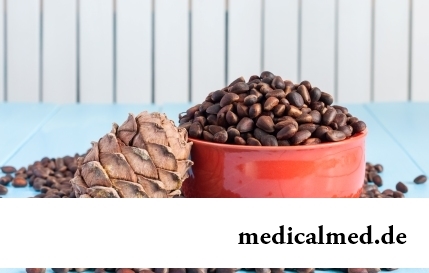





Cilantro
Cilantro or sowing coriander – an annual aromatic plant of family Umbrella with a spindle-shaped root. The plant blossoms in June-July, yields fruits in July-August, in more northern areas - in September.

Useful properties of cilantro are known to people already, at least, about 5 thousand years. Ancient Egyptians used a coriander both in cookery, and in medicine, put cilantro leaves in tombs of Pharaohs, considering that spice does the person immortal. In East Asia from seeds of a coriander the love herb prepared: exciting properties were ordered it.
The first mentioning of cilantro or coriander in Russia occurs in references of 1784, in works of the agronomist A. T. Bolotov. Gradually cilantro was entered into culture of mass crops in Russia: in 1830 columns Apraksin who took out seeds of "kolyandr" from Spain distributed them to peasants of the Voronezh province for disembarkation.
Today cilantro is widely cultivated in the North Caucasus, in the European part of Russia, in Ukraine and the CIS countries.
Useful properties of cilantro
Gastronomic and medicinal properties of a coriander impress: the vitamins C which are contained in spice, B1,B2,P, essential oils, carotene, tannins provide wound healing, cholagogue, protivogemorroyny, expectorant, antivermicular, laxative effects of cilantro.
Greens of cilantro are useful as fortifying means, being applied at diseases of a gall bladder, digestive tract, cardiovascular system. It is proved that the regular use of a coriander can promote treatment of gastritis, stomach ulcer and duodenum. The dish seasoned with several branches of cilantro will serve as the natural means clearing intestines of harmful bacteria.
Cilantro promotes improvement of appetite and process of digestion, improving process of digestion of heavy food, serves as the means recovering blood pressure and normalizing a dream.
Besides, the coriander is the most valuable antiscorbutic, and waste of cilantro is used as fodder product for a bird, pigs and rabbits.
Use of cilantro
From fruits of a coriander the essential oil used in cosmetology and perfumery for the purpose of giving to products of smells of a lily of the valley, a bergamot, a lily, a violet, a rose and many other plants prepares. After an otgonka essential oil is extracted in fat oil which then is used in soap manufacture and production of oleic acid - the substance applied in production of paints and varnishes. Besides, essential oil of cilantro is raw materials for citral aldehyde preparation – the medicine which is used at treatment of a keratitis, conjunctivitis, glaucomas and also elimination of cracks on nipples of nursing mothers.
Use in cookery
Young greens of cilantro in phases of the beginning of bolting and the socket are widely used as seasoning to meat dishes, soups and salads. Cilantro seeds also found the application: they are used as the spice flavoring and vitaminizing sausages, marinades, cheese, canned and fish meat, liqueurs, beer, confectionery. The extract of essential oils of cilantro is used in recipes of preparation of gins and some other alcoholic beverages.

Cilantro caloric content
Cilantro caloric content in a ground form - 216, 4 kcal. Nutrition value:
- Proteins - 3 g;
- Fats - 0 g;
- Carbohydrates - 54,5 g.
Contraindications
Despite numerous useful properties of cilantro, you should not abuse seasoning: the excessive use of a coriander can serve as a cause of infringement of a monthly cycle at women, a dream, weakening of a potentiality and memory.
It is at one time recommended to accept no more than 35 g of greens and 4 g of seeds of cilantro in food.
It is worth refusing addition of cilantro as seasoning to dishes to the people having gastritis with a hyperoxemia, coronary heart disease, thrombophlebitis, a hypertension, thrombosis, a diabetes mellitus and also the patients who had a myocardial infarction.
When lovers kiss, each of them loses 6,4 calories a minute, but at the same time they exchange nearly 300 species of various bacteria.

Tea is loved and use almost everything. This drink has tonic properties, contains the tannins capable podavlit...
Section: Articles about health
What will only not be thought up by persons interested to have a beautiful figure. Here the last innovation – for weight loss needs to be eaten greasy food. Let's understand whether there is at a fatty diet common sense....
Section: Slideshow
Diseases of joints often begin imperceptibly for the person. The first stages of destruction of the cartilaginous tissue providing soft and free sliding of heads of bones in joint bags proceed slowly and absolutely without serious consequences. Especially unpleasantly for the fact that this process is not connected with advanced age: degradation of joint surfaces is, as a rule, noticeable after 30 years. It means that practically each able-bodied person at any time can face sad results...
Section: Articles about health
According to data of World Health Organization, the cataract is diagnosed almost for 7% of the population of Earth. Statistics we get sick...
Section: Articles about health
Radiological methods of a research are applied in medicine more than hundred years, and thanks to them millions of lives were saved. In many cases without X-ray it is impossible to make exact idea of a condition of bodies and fabrics, it is correct to make the diagnosis. Those...
Section: Articles about health
Practice of use of table salt in the therapeutic purposes contains not one century. Applications which do by means of the fabric impregnated with saline solution are considered especially effective. They have antibacterial and antiinflammatory effect, help to heal wounds, exempt fabrics from excess liquid. Hypertonic salt solution of potassium chloride is applied outwardly at many morbid conditions. Let's tell about the most known of them....
Section: Articles about health
History of mankind contains several tens of epidemics whose emergence was compared by eyewitnesses and historians to doomsday. With...
Section: Articles about health
Shops of household appliances offer us the huge choice of various devices for the house. Whether there are among this abundance devices which not only facilitate house work, but also help to keep health of the person? Of course, and we will tell about them today....
Section: Articles about health
Let's begin with the fact that a separate illness which is called "adjournment of salts", just does not exist. In practice this household name of disbolism leading to development of a number of diseases. Pathological process consists that in an organism there is an accumulation of salts of uric acid (as a rule, owing to failure of a water salt metabolism or insufficiently effective work of secretory system)....
Section: Articles about health
Epilepsy is one of widespread neurologic diseases. To parents, whose children suffer from this illness, it is necessary...
Section: Articles about health
There is a lot of fans of beer in our country. Statistically, on each average Russian (including women and children) in a year about 60 liters of this drink are consumed. It is not a lot of, as in the Czech Republic or Germany, but figure all the same impressive. Radova...
Section: Articles about health
Climax - process of fading of reproductive function of an organism in process of its aging. At women the main sign of its approach is the termination of a menstrual cycle. Officially the menopause is diagnosed when periods are not observed within 12 months. Age changes quite often are followed by emotional failures, disturbance of thermal control and sweating, dizzinesses and headaches, tachycardia and other unpleasant phenomena. This complex of symptoms...
Section: Articles about health
Each woman has preferences in the field of use of those goods which help us to look good, feel се...
Section: Articles about health
Among a set of the perfumery and cosmetic goods which are released today the special group is made by the means containing antibacterial components. Such types of gels, shampoos, soaps, creams, lotions and other products are positioned by manufacturers as a panacea...
Section: Articles about health
For many women the word "fat" sounds as a sentence. In aspiration to an ideal figure they try to exclude, first of all, from the menu all dishes containing fats without having at the same time a clear idea of a role of these substances in exchange processes, and of effects for health with which food restrictions of this sort are fraught. For what the human body needs fats and as their deficit in a diet is shown, we also will try to find out....
Section: Articles about health
Bulimia and anorexia, are heavy deviations of a feeding behavior, become a cause of death of patients much more often than all others...
Section: Articles about health
The endocrine system carries out extremely important role in a human body, practically all processes of life activity are regulated by it. Closed glands (hemadens) produce special biologically active agents – hormones which then o...
Section: Articles about health
Aging — natural and inevitable process. Over time our skin loses elasticity, on it saggings are formed, the face form loses former clearness. The procedure of nitevy lifting (nitevy tightening) can successfully solve this problem. In order that it is better to get acquainted with this popular procedure, we will tell you 6 cognitive facts about it....
Section: Articles about health
Cystitis, or inflammation of a mucous membrane of a bladder, this very widespread disease, which, owing to some persons...
Section: Articles about health
The hysteromyoma is diagnosed more than at a third of women 35 years are more senior. This high-quality new growth which at early stages successfully resolves by means of medicines. It is necessary to resort to an operative measure only in those a case...
Section: Articles about health
Sugar - the digestible refined product which is not of special value for an organism of the modern person. The use of sugar in food is based rather on the psychological dependence caused by desire to indulge itself with something tasty, and further and the biological, caused need of an organism for glucose as a result of big emissions of insulin in blood. Such circulation of insulin and glucose with continuous increase in portions of sugar is rather offensive and can become the reason for a narusha...
Section: Articles about health
The words "disease" and "patient" not without reason come from one root – "pain". As a rule, symptoms of illnesses thoroughly spoil the patient...
Section: Articles about health
The mankind knows that some toxins at intake in the minimum quantities have therapeutic effect from an extreme antiquity. Many substances recognized poisonous are applied in the medical purposes also today, being the main deystvuyushch...
Section: Articles about health
The state of health of the person in many respects depends on chemical composition of biological liquids of an organism. Specialists consider that PH value of these solutions has to be in range of 7,35-7, 45. The deviation in the smaller party (so-called "acidulation") is fraught with development of many heavy illnesses, failures in work of immune system, decrease in working capacity and deterioration of life. To avoid serious fluctuations of acidity of internal liquids it is necessary to adhere разумног...
Section: Articles about health
Work of a brain is extremely complex and in many respects is not studied yet. It is confirmed also by the features of thought processes which are shown in...
Section: Articles about health
Each failure in work of bodies and systems of a human body is, as a rule, shown by the whole complex of symptoms. In particular, malfunctions with health often cause emergence of cosmetic defects in the form of rashes on a face. Experienced doctors know that локализац...
Section: Articles about health
Helminthosis is one of the most widespread diseases. Statistically, any species of helminths infected every third inhabitant of the planet. Most of specialists even consider these data strongly underestimated: some uninvited "cohabitants" do not cause the carriers serious troubles, and patients just do not see doctors. The situation is aggravated also with the fact that people know about specifics of similar illnesses very little. At many presence of worms is strong ассоциир...
Section: Articles about health
